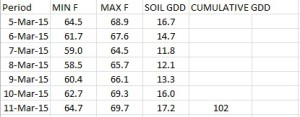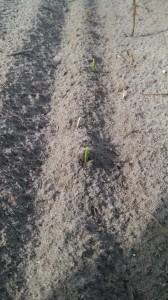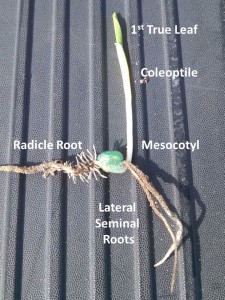Corn planters are starting to hit the fields of North Florida and we are seeing emergence on the first planted corn. Conditions have been near optimum for corn seed germination and plant emergence. I am always amazed at the process of a seed to develop into a plant and harvestable crop. The most amazing part is that it begins with a seed, and so much happens without human involvement.
As we watch these corn seeds germinate, I want to address plant development and the role of temperature. Corn plant development is temperature dependent, and the pattern we have seen this season is remarkably consistent with published data. Most readers are familiar with Corn Growing Degree Days, or Corn GDDs. Agronomists teach us that a corn seed needs 100 to 120 GDDs to emerge through the soil surface. It is important to know that until the corn plant emerges, we measure Corn GDDs by soil temperature, NOT air temperature.
WEATHER GEEKS, READ THIS. OTHERS SKIP THIS PARAGRAPH!!!Corn GDDs are calculated as (Max Temp+Min Temp)/2 – 50 degrees (base temp). For this calculation Max Temp cannot exceed 86 nor Min Temp below 50 degrees F. One would obviously expect if we used the maximum air temperature which was in the 80’s each day, GDD accumulation would be much more rapid. However that is not the temperatures the seeds are exposed to. Following emergence Corn GDD calculations will utilize the air temperature.
I revisited the soil temperature from the nearest FAWN weather station to compare plant emergence with soil temperature and accumulated Corn GDDs. The seed in these photos was planted on March 5th. The pictures I have included were taken at the end of the day March 11th. According to my calculations there were 102 accumulated Corn DDGs here over that 7 day period using soil temperatures. 
This is also a great opportunity to talk about what is going on with that seedling and the key parts of a corn plant. Here are a couple things to know about.
Coleoptile-Pointed protective sheath covering the emerging leaves in grass plants.
Mesocotyl-Plant part located between the kernel and the Coleoptile. Mesocotyl elongation elevates the Coleoptile to the soil surface. When the Coleoptile emerges, solar radiation signals hormone production and mesocotyl elongation stops.
Radicle root-The radicle root emerges from the tip end of the kernel first and elongates in the direction the seed was laying.
Seminal roots-The seminal roots emerge from behind the coleoptile and emerge in the opposite direction of the radicle. The seminal and radicle roots will soon grow downward due to gravity and will play a minor role in obtaining water for the developing plant. Nutrition will primarily come from the kernel until nodal roots are developed.
The sandy soils and warm temperatures of North Florida rarely result in emergence issues of corn in North Florida. However, it is always valuable to know what is going on below the soil, what to expect, and how weather conditions influence development.


